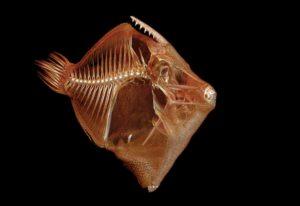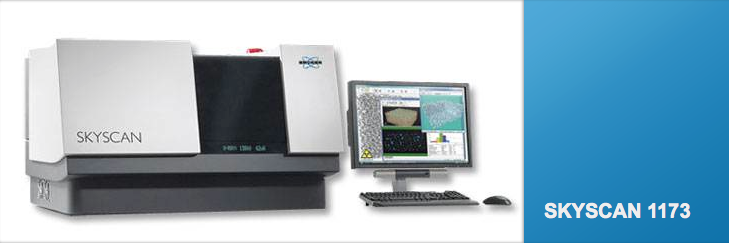 The last time I received a fish in the mail, it was the result of a horrible practical joke. But not all posted fish are so poorly received. In fact, Dr. Adam Summers, University of Washington Professor of Biology and Aquatic and Fishery Sciences, is only too happy to accept incoming specimens as part of his project to scan one of every fish in the world and make the data accessible to anyone, anywhere.
The last time I received a fish in the mail, it was the result of a horrible practical joke. But not all posted fish are so poorly received. In fact, Dr. Adam Summers, University of Washington Professor of Biology and Aquatic and Fishery Sciences, is only too happy to accept incoming specimens as part of his project to scan one of every fish in the world and make the data accessible to anyone, anywhere.
An obsessive/compulsive fantasy project that puts to shame those who only have 136 Pokémon to collect, this project is something that Dr. Summers has been working on for quite some time. In 2000 he was able to plead with a hospital to conduct a CT scan on a sting ray. The photos from that shoot might not have garnered the same publicity as the nude pics of Melania Trump, but they do hold the honor of being the first-ever CT scanned fish to grace the cover of a journal of biology.
Since then, Dr. Summers has been steadily amassing a collection of 3D scanned fish species in conjunction with hospitals, but found that each scan was still too costly, ranging from $500 to $2,000 a pop, to make his dream of an omni-specimen database into a reality. Unable to relinquish his vision, he instead raised $340,000 to purchase the Bruker SkyScan 1173 scanner that is now housed at the Friday Harbor Laboratories, and he makes the machine freely available to anyone interested in using it to scan their fish.
These aren’t just locally caught fish being slapped up on the bed; there is a requirement that the fish come from museum-accessioned collections. So far, he has managed to collect scans from 515 different species and the numbers are continuing to grow. Given that there are over 25,000 species of fish on our planet, it’s a good thing that it turns out he’s not the only one interested in this project. It’s an even better thing that he has developed methods for scanning multiple specimens at once. He does this by creating a rolled up bundle of the fish for scanning and then separating the data into individual fish after the scan is complete.
 Part of what has enabled him to work so quickly is that he doesn’t scan at the highest resolution, as that kind of detailed data is generally not needed by scientists. Being able to work well with others has also helped speed the project along, as he explained:
Part of what has enabled him to work so quickly is that he doesn’t scan at the highest resolution, as that kind of detailed data is generally not needed by scientists. Being able to work well with others has also helped speed the project along, as he explained:
“We just made it a group effort to get everything done. Having this scanner has made it clear to me the incredible power of this system if you think about it the right way…The way transformative ideas do, these just instantly changed the way we think about scanning specimens. We went from ‘Is this possible?’ to scanning whole series of fishes quickly.”
 The specimens have come from collections housed at the University of Washington and also from sources as varied as Ohio State University and the Western Australian Museum, among others. It would seem that Dr. Summers might have his hands full for quite some time getting this collection completed, but that hasn’t stopped him from setting his sights on an even bigger project: scanning all 50,000 vertebrate species. For a project of that size, he’s going to need more than a little help from his friends, but his colleagues at museums around the country are writing a grant proposal to help push the initiative forward.
The specimens have come from collections housed at the University of Washington and also from sources as varied as Ohio State University and the Western Australian Museum, among others. It would seem that Dr. Summers might have his hands full for quite some time getting this collection completed, but that hasn’t stopped him from setting his sights on an even bigger project: scanning all 50,000 vertebrate species. For a project of that size, he’s going to need more than a little help from his friends, but his colleagues at museums around the country are writing a grant proposal to help push the initiative forward.
Dr. Summers estimates that the fish scanning project will be completed in the next few years, and as the scans are finished, he is posting them online to Open Science Framework so they can be utilized by all who need them. Thoughts on this project? Let’s discuss the top further over in the 3D Scanning Fish Species forum at 3DPB.com.
[Source/Images: University of Washington]
Subscribe to Our Email Newsletter
Stay up-to-date on all the latest news from the 3D printing industry and receive information and offers from third party vendors.
Print Services
Upload your 3D Models and get them printed quickly and efficiently.
You May Also Like
Titomic Opens New U.S. Facility in Huntsville to Boost 3D Printing for Defense
Australian company Titomic (ASX: TTT) has expanded into Huntsville, Alabama, opening a new U.S. facility that brings its advanced metal manufacturing technology closer to key defense and aerospace hubs. The...
Steadfast XO: Will USVs and UUVs Disrupt Existing Naval Power?
A quiet revolution is underway in Unmanned Surface Vehicles (USV) & Unmanned Underwater Vehicles (UUV). Ukraine didn’t have much of a Navy when Russia invaded, but has been able to...
Recipe for an AM Cluster: ADDIMAT’s Zubizarreta on the Making of the Spanish AM Ecosystem
One of the most significant themes in the global manufacturing sector throughout the last decade has been the nurturing of existing economic clusters and the seeding of new ones by...
Nikon Advanced Manufacturing & America Makes to Develop Aluminum Powder Dataset
Nikon Advanced Manufacturing Inc., the Long Beach-based end-to-end metal additive manufacturing (AM) firm, has announced that the company is partnering with the Manufacturing USA Institute America Makes to develop an...

































